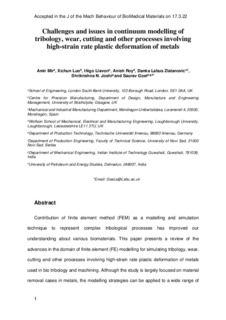| dc.contributor.author | Llavori, Inigo | |
| dc.contributor.other | Mir, Amir | |
| dc.contributor.other | Luo, Xichun | |
| dc.contributor.other | Roy, Anish | |
| dc.contributor.other | Labus Zlatanovic, Danka | |
| dc.contributor.other | Joshi, Shrikrishna Nandkishor | |
| dc.contributor.other | Goel, Saurav | |
| dc.date.accessioned | 2022-04-12T11:43:37Z | |
| dc.date.available | 2022-04-12T11:43:37Z | |
| dc.date.issued | 2022 | |
| dc.identifier.issn | 1751-6161 | en |
| dc.identifier.other | https://katalogoa.mondragon.edu/janium-bin/janium_login_opac.pl?find&ficha_no=167569 | en |
| dc.identifier.uri | https://hdl.handle.net/20.500.11984/5527 | |
| dc.description.abstract | Contribution of finite element method (FEM) as a modelling and simulation technique to represent complex tribological processes has improved our understanding about various biomaterials. This paper presents a review of the advances in the domain of finite element (FE) modelling for simulating tribology, wear, cutting and other processes involving high-strain rate plastic deformation of metals used in bio tribology and machining. Although the study is largely focused on material removal cases in metals, the modelling strategies can be applied to a wide range of other materials. This study discusses the development of friction models, meshing and remeshing strategies, and constitutive material models. The mesh-based and meshless formulations employed for bio tribological simulations with their advantages and limitations are also discussed. The output solution variables including scratch forces, local temperature, residual stresses are analyzed as a function of input variables. | en |
| dc.language.iso | eng | en |
| dc.publisher | Elsevier Ltd. | en |
| dc.rights | © 2022 Published by Elsevier Ltd. | en |
| dc.subject | Finite element | en |
| dc.subject | Lagrangian | en |
| dc.subject | ALE | en |
| dc.subject | Meshless | en |
| dc.subject | chip formation | en |
| dc.title | Challenges and issues in continuum modelling of tribology, wear, cutting and other processes involving high-strain rate plastic deformation of metals | en |
| dcterms.accessRights | http://purl.org/coar/access_right/c_f1cf | en |
| dcterms.source | Journal of the Mechanical Behavior of Biomedical Materials | en |
| local.contributor.group | Diseño y mecánica estructural | es |
| local.contributor.group | Tecnologías de superficies | es |
| local.description.peerreviewed | true | en |
| local.identifier.doi | https://doi.org/10.1016/j.jmbbm.2022.105185 | en |
| local.embargo.enddate | 2024-03-31 | |
| local.contributor.otherinstitution | https://ror.org/02vwnat91 | es |
| local.contributor.otherinstitution | https://ror.org/00n3w3b69 | es |
| local.contributor.otherinstitution | https://ror.org/04vg4w365 | es |
| local.contributor.otherinstitution | https://ror.org/01weqhp73 | es |
| local.contributor.otherinstitution | https://ror.org/00xa57a59 | es |
| local.contributor.otherinstitution | https://ror.org/04q2jes40 | es |
| local.source.details | Vol. 130. N. artículo 105185, 2022 | en |
| oaire.format.mimetype | application/pdf | |
| oaire.file | $DSPACE\assetstore | |
| oaire.resourceType | http://purl.org/coar/resource_type/c_6501 | en |
| oaire.version | http://purl.org/coar/version/c_ab4af688f83e57aa | en |







